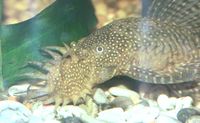Bristlenose Catfish (Ancistrus sp.)
From The Aquarium Wiki
Bristlenose Catfish
Ancistrus sp.
57 Litres (15 US G.)
12.7-15.2cm (5-6 ")
Freshwater
5.8 - 7.5
21.1-26.1°C (70 -79 °F)
6-13 °d
1:1 M:F
8-25 years
Family
Loricariidae
This animal is available captive bred
Contents
Additional names
- Bristlenose Pleco, Bristlenose Catfish, Bushynose Catfish, Brushmouth Pleco, Common Bristlenose, Common Bristlenose Catfish, Veiltail Bristlenose, Piebald Bristlenose, Albino Veiltail, Golden Ancistrus
Origin[edit]
- These strange looking fish are found throughout the Amazon River basin. They live in fast flowing, clear streams and like to hide under driftwood.
Sexing[edit]
- Gender can be determined at roughly six months of age, and reach maturity at about eleven months. Females have short, thin, pointed barbels on the snout. Males have many longer, thicker barbels covering the snout.
Breeding[edit]
- Ancistrus sp. will often breed in a community tank if appropriate caves are supplied. Other fish, particularly cichlids, can eat the fry should they be small enough to consume.
- Provide horizontal caves somewhat longer than the male's body, and big enough for him to fit inside with his fins extended. The best caves are drilled into bogwood or driftwood, or carved out of the underside of a branch. Some breeders have used PVC pipe of suitable size.
- Males will seek out these caves and lure females to enter and lay eggs. After she lays eggs, the female has nothing more to do with raising the fry. The male will stay in the cave until the eggs hatch (6+ days) and the fry become free-swimming (4+ days). He will try to keep them in the cave as long as possible, but once they become free swimming, they will leave to seek food. Many breeders have had great success removing the cave with the male and the eggs after fertilization to a safe fry tank, to prevent the fry from escaping and being eaten by other tank inhabitants. Other breeders take just the cave with the eggs, which may or may not allow the male to start eating sooner to recover his strength.
- Feed fry algae, kelp flakes, spirulina tablets and frozen peas with shells removed. Removing the shells from peas is important for small fry, which can become trapped in the shell and possibly die. Fry are not able to bite through the shell until they are several months old.
- Some pairs will produce a new clutch of eggs every 4-6 weeks. Clutches can range from 40-250 fry.
Tank compatibility[edit]
- Bristlenose Catfish are entirely peaceful tank inhabitants. They will work well in a peaceful community tank. They will co-habit with their own kind, but two males may argue over territory.
Diet[edit]
- They'll take a wide number of vegetable-based foods including soft algae, cucumber, mushrooms, shelled garden peas, spinach, zucchini(courgettes), catfish pellets and flake, small amounts of bloodworm or chopped earthworm occasionally. Juvenile fish will lean towards a more meaty diet to include small live foods like brine shrimp and daphnia.
Feeding regime[edit]
- Will feed on algae constantly. If tank is low on algae, feed extra algae tablets or other par-boiled vegetables as mentioned above.
- This fish will eat the surface of Amazon swords (and other similar plant leaves) leaving pitted holes in them if not fed enough!
Environment specifics[edit]
- Planted tank with lots of places to hide for security. 121.9cm (48") long tank can hold two pairs of Bristlenoses. Bogwood décor is a must,[1][2] they need places provided in which they can hide. Be careful with exposed heaters or filter set ups as young Bristlenose Catfish may try and seek shelter in these places and could get hurt.
Behaviour[edit]
- Very gentle. Ideal community fish. Quite often visible during the day when young. Most active at night when mature. Adult males will be territorial against other males. If bought when very young then they will be more used to you and therefore more visible during the day. Be wary keeping with slow-moving high-sided fish as these Plecos may develop a taste for slime coats.
Identification[edit]
- Historically commonly available species of Ancistrus were Ancistrus dolichopterus and Ancistrus temminckii, other species are now available, though exact identification is difficult because so many are not yet fully described. For these reasons, they are most commonly called Ancistrus sp..
Special Notes[edit]
- The Ancistrus species like many plecos has an interesting adaptation of being able to live in water with reduced oxygen. It adapts a part of its digestion system to absorb oxygen from gulps of air, rather like the Corydoras species.
- When buying Bristlenose Catfish, buying juveniles under 2" long must be done with caution. They are exceptionally fragile at this size and should only be attempted by experienced fishkeepers with mature tanks teeming with algae ready to go.
Pictures[edit]
Videos[edit]
References[edit]
External links[edit]
- Fishbase (Mirrors:
 )
)
- Wikipedia
- Tropical Fish Friends
- Scotcat - Golden Ancistrust
- Planet Catfish
- The Tropical Tank
- Auburn.edu - 59 species of Ancistrus
- Aquatic Community - Breeding Bristlenose Catfish
- Planet Catfish - Article by Kathy Jinkings on Bristlenoses
- Planet Catfish - Book Review of 'Bristlenoses Catfish with Character'
- Fish Profiles
- Sydney Cichlid
- E-Aquarium - With Videos
- Bristlenose Catfish
- Connect Fish Friends - Super Red Bristlenose







